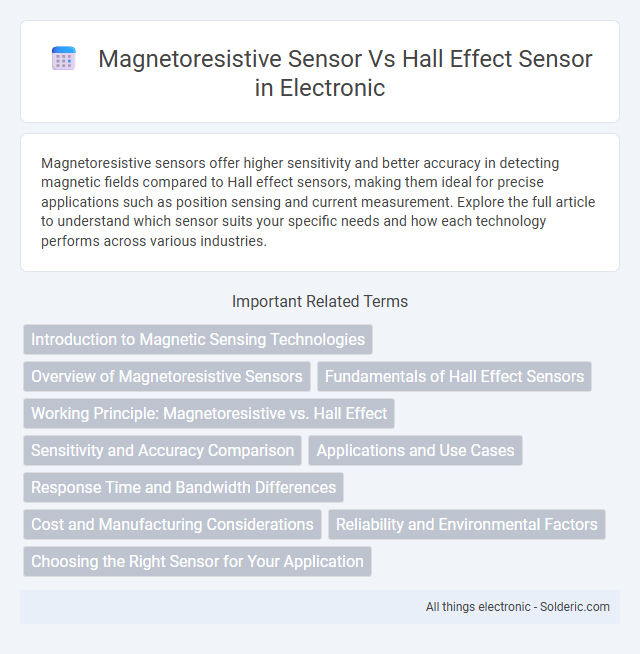Magnetoresistive sensors offer higher sensitivity and better accuracy in detecting magnetic fields compared to Hall effect sensors, making them ideal for precise applications such as position sensing and current measurement. Explore the full article to understand which sensor suits your specific needs and how each technology performs across various industries.
Comparison Table
| Feature | Magnetoresistive Sensor | Hall Effect Sensor |
|---|---|---|
| Operating Principle | Changes resistance in response to magnetic field | Generates voltage perpendicular to magnetic field |
| Sensitivity | High sensitivity to low magnetic fields | Moderate sensitivity |
| Response Time | Fast response time | Moderate response time |
| Output Signal | Analog resistance change | Voltage output |
| Power Consumption | Low power consumption | Higher power consumption compared to MR |
| Applications | Position sensing, speed detection, current sensing | Position sensing, current sensing, proximity detection |
| Temperature Stability | Moderate temperature stability | Good temperature stability |
| Cost | Generally higher cost | Lower cost |
Introduction to Magnetic Sensing Technologies
Magnetoresistive sensors detect changes in electrical resistance caused by external magnetic fields, offering high sensitivity and precision in measuring magnetic variations. Hall effect sensors operate by producing a voltage proportional to the magnetic field perpendicular to the current flow, providing reliable and cost-effective magnetic field detection. Choosing the right technology for your application depends on factors such as sensitivity requirements, environmental conditions, and size constraints.
Overview of Magnetoresistive Sensors
Magnetoresistive sensors detect changes in electrical resistance caused by external magnetic fields, offering high sensitivity and accuracy for precise magnetic field measurements. They outperform Hall effect sensors in detecting low magnetic flux densities and provide better linearity, making them ideal for applications requiring fine magnetic resolution. Your choice between these sensors depends on the specific requirements for sensitivity, accuracy, and environmental conditions in your magnetic sensing application.
Fundamentals of Hall Effect Sensors
Hall effect sensors operate based on the Hall effect principle, where a voltage is generated perpendicular to an electric current in a conductor exposed to a magnetic field. These sensors measure magnetic flux density and are widely used in position, speed, and current sensing applications due to their simplicity and robustness. Unlike magnetoresistive sensors, Hall effect sensors provide linear output and are less sensitive to external magnetic noise.
Working Principle: Magnetoresistive vs. Hall Effect
Magnetoresistive sensors operate by detecting changes in electrical resistance caused by the alignment of magnetic domains in a material under an external magnetic field. Hall effect sensors generate a voltage difference transverse to the current flow when exposed to a magnetic field, based on the Lorentz force acting on charge carriers. The magnetoresistive effect typically offers higher sensitivity and better resolution compared to the Hall effect, making it advantageous for precise magnetic field measurements.
Sensitivity and Accuracy Comparison
Magnetoresistive sensors exhibit higher sensitivity and accuracy compared to Hall effect sensors due to their ability to detect minute changes in magnetic fields with greater precision. These sensors utilize the magnetoresistance effect, enabling enhanced signal-to-noise ratios and finer resolution in magnetic field measurements. Hall effect sensors, while robust and cost-effective, typically offer lower sensitivity and accuracy, making them less suitable for applications requiring precise magnetic field detection.
Applications and Use Cases
Magnetoresistive sensors excel in applications requiring high sensitivity and precise measurement of magnetic fields, such as in hard disk drives, automotive position detection, and current sensing in power electronics. Hall effect sensors are widely used in speed detection for motors, proximity sensing, and magnetic field detection in consumer electronics due to their robustness and cost-effectiveness. Both sensor types find critical roles in industrial automation, robotics, and automotive systems, with magnetoresistive sensors favored for higher accuracy and Hall sensors preferred for basic positional feedback.
Response Time and Bandwidth Differences
Magnetoresistive sensors exhibit faster response times and higher bandwidth compared to Hall effect sensors, making them ideal for applications requiring rapid magnetic field detection. The intrinsic physical properties of magnetoresistive elements enable them to detect changes in magnetic flux with minimal delay, offering bandwidths that can reach several megahertz. In contrast, Hall effect sensors generally have slower response times and narrower bandwidths, typically limited to tens or hundreds of kilohertz due to their reliance on carrier mobility within a semiconductor.
Cost and Manufacturing Considerations
Magnetoresistive sensors typically involve more complex materials and fabrication processes, leading to higher manufacturing costs compared to Hall effect sensors, which use simpler semiconductor-based technology. The production scale of Hall effect sensors benefits from mature semiconductor manufacturing infrastructure, resulting in lower unit costs and greater availability. Cost efficiency in applications often favors Hall effect sensors unless the enhanced sensitivity and precision of magnetoresistive sensors justify the increased investment.
Reliability and Environmental Factors
Magnetoresistive sensors offer higher sensitivity and better reliability under varying environmental conditions compared to Hall effect sensors, making them ideal for applications exposed to temperature fluctuations and electromagnetic interference. You benefit from their enhanced durability and stability in harsh environments such as automotive or industrial settings. Hall effect sensors, while robust, are more susceptible to noise and less accurate in fluctuating temperatures, impacting long-term reliability.
Choosing the Right Sensor for Your Application
Magnetoresistive sensors provide higher sensitivity and better accuracy in detecting magnetic fields compared to Hall effect sensors, making them ideal for applications requiring precise measurements. Hall effect sensors offer simpler integration and cost-effectiveness, suitable for general purpose or high-volume projects. Evaluate your application's sensitivity requirements, environmental conditions, and budget to choose the right sensor that ensures optimal performance and reliability.
Magnetoresistive sensor vs Hall effect sensor Infographic

 solderic.com
solderic.com